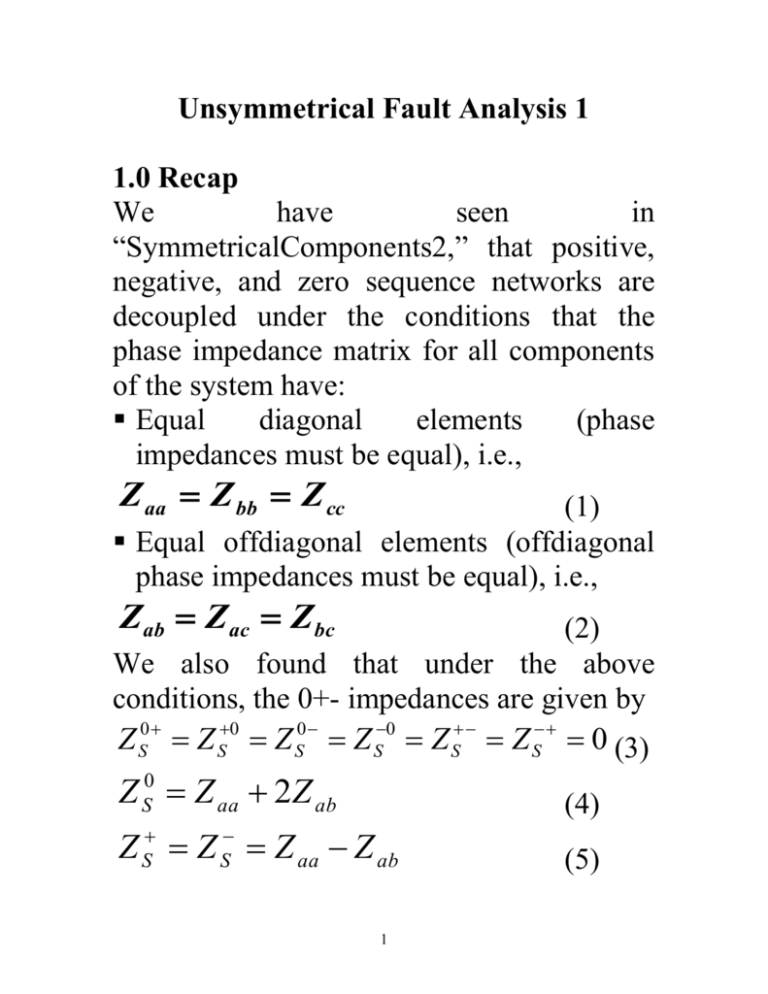doc - Iowa State University
advertisement

Unsymmetrical Fault Analysis 1 1.0 Recap We have seen in “SymmetricalComponents2,” that positive, negative, and zero sequence networks are decoupled under the conditions that the phase impedance matrix for all components of the system have: Equal diagonal elements (phase impedances must be equal), i.e., Z aa Z bb Z cc (1) Equal offdiagonal elements (offdiagonal phase impedances must be equal), i.e., Z ab Z ac Z bc (2) We also found that under the above conditions, the 0+- impedances are given by Z S0 Z S0 Z S0 Z S0 Z S Z S 0 (3) Z Z aa 2Z ab 0 S S (4) S Z Z Z aa Z ab 1 (5) The resulting sequence networks are shown in Fig. 1. I a0 Z0 Va0 Zero sequence network a V I a Z+ Positive sequence network Va I a Z- Negative sequence network Fig. 1 Distribution systems generally do not satisfy the requirements in (1) and (2) above since transposition is not used, that is, distribution systems are not symmetric. Transmission systems generally do satisfy the requirements in (1) and (2). 2 2.0 Important concept Section 12.2 of your text provides a very good conceptual description of using symmetrical components in fault analysis. I condense this discussion here for you. Please read it, and digest/absorb it!!! SC provides 3 decoupled systems for analysis of unbalanced sources applied to a symmetrical system. Faulted symmetrical systems (except for 3phase faults) are not symmetrical systems, so it would appear that SC are not much good for SLG, 2LG, and LL faults. But we can replace the fault with an unbalanced source (substitution theorem), then the network becomes symmetric. Then get the sequence components of the (fictitious) unbalanced source at the fault point, then you can perform per-phase analysis on each sequence circuit. 3 3.0 Developing sequence networks Basic steps in using symmetrical components for assessing faulted conditions are (all quantities are assumed to be in pu). A. For positive, negative, & zero sequence: 1.Develop the sequence network for the system under analysis. 2.Obtain the Thevenin equivalents looking into the network from the fault point. B. Connect the networks to capture the influence of the particular fault type. C. Compute the fault current from the circuit resulting from step B. D. From step C, you will also determine the currents in all three of the networks (positive, negative, and zero sequence currents). This enables computation of the phase currents Ia, Ib, and Ic from Iabc=AIS. We discuss each one of these steps in what follows. 4 We address loads, lines, transformers, & generators. For each of these, we may derive expressions for the 0+- sequence impedances via the following steps: 1.Express abc voltages as a function of abc currents and abc impedances. 2.Substitute symmetric components for abc voltages and currents (e.g., Vabc=AVS and Iabc=AIS). 3.Manipulate to obtain the form VS=ZSIS. If you refer back to “SymmetricalComponents2,” you will see that this is the procedure we followed to obtain 0+- sequence impedances for a Yconnected load. However, in what follows, we will not go through the analytical details but will rather just state the results. 5 3.1 Loads (see section 12.6 of text) Recall from “SymmetricalComponents2” that for a Y-connected, balanced load grounded through a neutral impedance Zn with impedance ZY per phase, the 0+sequence circuits are as in Fig. 2. I a0 ZY Va0 Z0=ZY+3Zn 3Zn Zero sequence network a V I a ZY Z+ =ZY ZY Z- =ZY Positive sequence network Va I a Negative sequence network Fig. 2 where we see the sequence impedances are: Z0 =ZY+3Zn (6) Z+ =ZY (7) Z- =ZY (8) 6 If the neutral is solidly grounded, then Zn=0 and eq. (6) above becomes Z0=ZY. If the neutral is ungrounded, then Zn=∞, and eq. (6) above becomes Z0=∞, i.e., the 0sequence circuit is an open circuit, implying no 0-sequence current flows in an ungrounded Y connection. For a delta-connected, balanced load, we simply convert to an equivalent Y using ZY=ZΔ/3 and then apply relations for an ungrounded Y connection, resulting in Z0 =∞ (9) Z1 = ZΔ/3 (10) Z- = ZΔ/3 (11) Example: A delta connected balanced load with phase impedance ZΔ is in parallel with a solidly grounded Y-connected load with phase impedance ZY. Draw the sequence networks for the entire paralleled load. 7 It is possible to develop the sequence networks using the 3-step approach given above (and I have notes that do that). However, this is very painful. Intuition, which suggests that we should just obtain the sequence networks of the parallel combination as parallel combinations of the individual sequence networks, is right. Figure 3 shows the result. I a0 ZY Va0 Z0 =ZY Zero sequence network a V I a ZΔ/3 ZY Z+ =ZY//ZΔ/3 ZY Z- =ZY//ZΔ/3 Positive sequence network Va I a ZΔ/3 Negative sequence network Fig. 3 8 3.2 Lines (see section 12.9 of text) In “SymmetricalComponents2,” the work we did to answer the question of “What if the load (or line, or load and line) is not symmetric?” led to another question, which was: “So what are the conditions for the offdiagonal elements of ZS to be 0?” We have already reviewed the answer to this question in Section 1.0 above, which was: Equal diagonal elements (phase impedances must be equal), i.e., Z aa Z bb Z cc (1) Equal offdiagonal elements (offdiagonal phase impedances must be equal), i.e., Z ab Z ac Z bc (2) In this case, the 0+- sequence impedances are [1, p. 28-30]: Z S0 Z S0 Z S0 Z S0 Z S Z S 0 (3) Z S0 Z aa 2Z ab (4) Z S Z S Z aa Z ab (5) 9 Equation (3) simply says that all offdiagonal elements on the 0+- sequence impedance matrix are zero. Equations (4) and (5) provide the actual expressions that we need for the 0, positive, and negative sequence impedances. These expressions apply to transmission lines because transposition makes conditions (1, 2) true. The sequence networks are given in Fig. 4. Z0 I a0 Va0 Z0 =Zaa+2Zab Zero sequence network a V I a Z+ Z+ =Zaa-Zab Positive sequence network Z- Va I a Z- =Zaa-Zab Negative sequence network Fig. 4 10 It is interesting to compare eqs. (4) and (5) for a symmetric line, and note that they indicate that the zero-sequence quantity is larger than the positive and negative sequence quantities by 3Zab. A typical overhead line has Zab≈(2/5)Zaa. In this case, it is easy to show that Z0=3Z+, suggesting that finding zero sequence impedance 3 times as large as positive sequence impedance, is quite typical (see bottom of page 474 in text). 3.3 Transformers (see Sec. 12.8 of text) There are five different types of transformer connections to assess. These are: 1.Grounded Y to grounded Y. 2.Grounded Y to Y or Y to grounded Y. 3.Δ-Δ 4.Grounded Y to Δ or Δ to grounded Y 5.Y-Δ or Δ-Y. 11 As before, we can perform our 3-step procedure given at the end of Section 3.0 (pg. 5), where we express abc quantities, substitute in symmetrical components, and then obtain the decoupled equations. Here, however, we must repeat this for both sides of the transformer and then relate the two sets of equations. We will not perform this tedious work but will instead simply observe general guides for drawing appropriate sequence circuits. In forming these guides, we assume: Exciting current is negligible so shunt path is infinite impedance and we only have the series Z (winding resistance and leakage reactance) in our transformer abc model. Transformers in Δ-Y or Y-Δ configuration are always connected so that positive sequence voltages on the high side lead positive sequence voltages on the low side by 30º (per industry convention). See pp. 139-140 for more on xfmr 30° phase shift. 12 General guidelines for transformer 0+sequence circuits: 1.Positive and negative sequence impedances are equal, i.e., Z+ =Z- =Zseries where Zseries is the transformer winding resistance and leakage reactance. 2.For connection types 4 and 5 in the above list (pg. 11), the phase shift is included from low side to high side as +30º for positive sequence -30º for negative sequence Let’s take a brief “aside” to look at this. a. Why does a Δ-Y or Y-Δ xfmr have a 30º phase shift for positive sequence quantities? Consider a Y-Δ. Across the winding, it is Van/VAB, but on the Yside, the line-line voltage is Vab=√3Van/_30º, so line-line voltage ratio is Vab/VAB=√3Van/_30º/ VAB. b.Why does negative sequence use -30º? Consider the Y-side in our Y-Δ. From KVL, Vab=Van-Vbn. See Fig. 5. 13 i. Positive sequence: Vbn=Van/_-120 ii. Negative sequence: Vbn=Van/_+120 Vab=Van-Vbn Vbn 120° 30° Van 30° Van Vbn 120° Negative sequence relation Positive sequence relation Vab=Van-Vbn Flow and pass-through Flow, but no pass-through.. No flow. Fig. 5 3.For zero-sequence network, a. We get a complete open circuit (I0 =0) if there is an ungrounded Y on one or both sides. b.We get isolation of primary from secondary if there is a Δ on one or both sides. This means that Δ connection prevents pass-through of zero-sequence currents. However, we may still get zero-sequence current flowing if the other side is grounded Y or Δ. c. We get no isolation if both sides are grounded-Y. 14 d.Z0 =Zseries+3Znp+3Zns where: Znp: neutral impedance on primary Zns: neutral impedance on secondary Two concepts important in understanding the points under (3) above are: There must be a connection to ground on the primary (secondary) side for zerosequence current to flow between the primary (secondary)-side system and the primary (secondary) side of the transformer. If zero-sequence currents cannot flow on primary (secondary) side of the transformer, then because currents on the secondary (primary) side of the transformer can only arise through induction of currents on the primary (secondary) side of the transformer, zerosequence currents also cannot flow on the secondary (primary) side of the transformer. So let’s draw 0+- sequence circuits for various transformer connections…. 15 1.Grounded Y to grounded Y. Z0 I a0 Va0 Zero sequence network Va I a Z+ Positive sequence network Z- Va I a Negative sequence network Fig. 5 16 2.Grounded Y to Y or Y to grounded Y. I a0 Z0 Va0 Zero sequence network Va I a Z+ Positive sequence network Z- Va I a Negative sequence network Fig. 6 Here, there is no place for zero-sequence currents to flow on the Y side (since there is no neutral and sum of phase currents, which equals 3Ia0, must be 0). Therefore, there can be no zero-sequence currents flowing on the other side either. So Ia0=0 for this connection. Y to grounded Y is the same. 17 3.Δ-Δ Z0 I a0 Va0 Zero sequence network Va I a Z+ Positive sequence network a V I a Z- Negative sequence network Fig. 7 Here, zero sequence currents cannot enter or leave either Δ winding, so for all practical purposes, the zero-sequence circuit is an open on both sides. 18 4.Grounded Y to Δ or Δ to grounded Y Z0 I a0 Va0 Zero sequence network ωωω Va I 1 : 30 ωωω a Z+ Low side Positive sequence network ωωω Va I a ωωω 1 : 30 Z- Low side Negative sequence network Fig. 8: Grounded Y to Δ Z0 Va0 I a0 I A0 Zero sequence network 1 : 30 ωωω Va I ωωω a Z+ Low side Positive sequence network ωωω Va I a ωωω 1 : 30 Z- Low side Negative sequence network Fig. 9: Δ to Grounded Y 19 In Figs. 8 and 9, we observe that zero sequence currents can flow out of the grounded Y side, which means they also must be able to flow within the Δ (but not out of the Δ). We also observe that, in both Figs. 8 and 9: -30º phase shift occurs of low side quantities relative to high side quantities for positive sequence (which implies high side leads low side by 30º for positive sequence quantities, in conformance with industry convention) 30º phase shift occurs of low side quantities relative to high side quantities for negative sequence (which implies high side quantities lag low side by 30º for negative sequence, in conformance with industry convention). 20 5.Y-Δ or Δ-Y. Z0 I a0 Va0 Zero sequence network 1 : 30 ωωω Va I ωωω a Z+ Low side Positive sequence network ωωω Va I 1 : 30 ωωω a Z- Low side Negative sequence network Fig. 10: Y to Δ Z0 Va0 I a0 I A0 Zero sequence network 1 : 30 ωωω Va I ωωω a Z+ Low side Positive sequence network ωωω Va I a ωωω 1 : 30 Z- Low side Negative sequence network Fig. 11: Δ to Y 21 Observe that Figs. 10 and 11 are exactly like Figs. 8 and 9 in the positive and negative sequence circuits. The only difference is the zero-sequence circuit, where we see that, in Figs. 10 and 11, not only can zero-sequence currents not pass through (which is the case in Figs. 8 and 9) but they cannot flow at all. 3.4 Rotating machines (see sec 12.7, text) Development of sequence impedances for the synchronous machine requires significant effort together with background in two-reactance theory, including the Park’s transformation. We do not have that background. Your text offers some of that background in chapter 7, and in Appendix 5. Additional references include [1, chap. 6], [2, chap. 1]. Here we simply provide some comments. 22 Positive sequence reactance: As in the symmetrical fault analysis, we will just use Xd, X’d, or X’’d, depending on what time frame of interest we have. This is quite reasonable for smooth rotor machines, but approximate for salient pole-machines. Negative sequence reactance: The negative sequence currents set up flux in the air gap that rotates opposite to the rotor and therefore sweeps rapidly over the face of the rotor, inducing currents in the iron which counteract the original flux. This condition is similar to the rapidly changing flux immediately upon the occurrence of a short circuit at the machine terminals. As a result, the negative sequence reactance is generally assumed equal to X’’d. 23 Zero-sequence: Two comments: 1.The zero sequence reactance is typically quite small. The reason for this is that the zero sequence currents in the a, b, and c windings are in-phase. Their individual fluxes in the air gap sum to zero and therefore induce no voltage, so the only effect to be modeled is due to leakage 0 Z reactance. We call this g . 2.As with loads, if the neutral is grounded through an impedance Zn, because 3 times the zero sequence current flows through Zn, we model 3Zn in the zero sequence network. Therefore we have, for generators, that Z 0 Z g0 3Z n (12) Voltage source: Finally, because generators produce balanced positive sequence voltages, generators produce no negative or zero sequence voltages. Therefore, we model a voltage source only in the positive sequence circuit. 24 When working in per-unit (as we have been assuming throughout this discussion), the positive sequence source voltage is typically assumed to be Ean=1.0. Although it actually may be something a little different than 1.0, the influence on final short circuit currents calculated is negligible. Z0 I a0 Va0 Zero sequence network Z+ + Ean - I a V a Positive sequence network Z- I a Va Negative sequence network Fig. 12 25 Your text provides a table of typical synchronous machine reactances, see Table 12.1 of pp. 468. You can compare this table with a similar one below that I obtained from another reference [3]. All values are in per-unit on the MVA base of the machine. + X XX0 Xd X’d X’’d Smooth Rotor 1.1 0.23 0.12 0.13 0.05 Salient Pole 1.15 0.37 0.24 0.29 0.11 Synchronous Motor Condensers 1.8 1.2 0.4 0.35 0.25 0.30 0.27 0.35 0.09 0.16 HW4: Due Tuesday, Feb 10, 2015. In your text: 12.2, 12.3, 12.9, 12.10, 12.11, 12.12, 12.17 [1] P. Anderson, “Analysis of Faulted Power Systems,” Iowa State University Press, 1973. [2] E. Kimbark, “Power system stability, Vol. II, Synchronous Machines,” 1995 by IEEE (Originally published in 1955). [3] J. Glover and M. Sarma, “Power system analysis and design,” PWS Publishers, 1987 26






